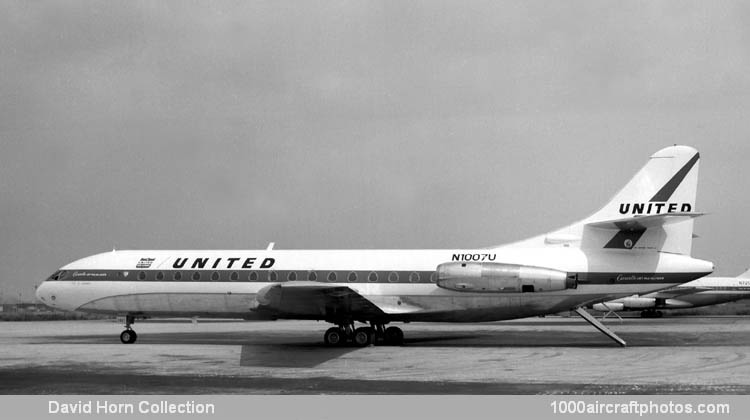As the order list continued to grow, an increasing number of customers began to demand the Caravelle Series VI, which from 1961 became the major production model. With a marked boost in performance brought about by the employment of still more powerful Avons, this was available in Series VI-N form with noise-suppressed 12,200 lb (5,534 kg) st Rolls-Royce Avon 531Bs, or as the Series VI-R with reverse-thrust 12,600 lb (5,715 kg) st Avon 533Rs. Prototype for the series VI-N (F-WJAQ c/n 19) was re-flown in its new form on 10th September 1960. A separate prototype for the VI-R (F-WJAP c/n 62) was flown on February 6, 1961.
The first and major customer for the Series VI-R was United Air Lines, which had ordered a fleet of 20 of this version on February 25, 1960. This represented the largest single order so far placed for any Caravelle variant, and was the more noteworthy for having come from a US operator. More than two hundred refinements were embodied in the Caravelle VI-R in order to conform to American civil aviation requirements. Most of these were detail changes; outwardly, the chief visible modifications were the bulged roof over the crew cabin, a modified windscreen of greater area, and triple-section spoilers on each wing trailing edge.
Both versions of the Caravelle VI have the main structures and landing gear reinforced in order to reap full benefit from the extra thrust of their higher-powered Avon engines. The first production Series VI-N (OO-SRA c/n 64) was delivered to SABENA on 20th January 1961, two days after the first VI-R (N1001U c/n 86) was accepted by United. Services were started respectively by SABENA (Brussels-Nice) on February 18, 1961, and by United (following F.A.A. type approval of the Series VI-R on June 5) between New York and Chicago on July 14.
The pictured aircraft was built in 1961 and first flew registered as F-WJAM. It was delivered to United in August 1961 and named Ville de Countences. It served with United till May 26, 1970, when it was leased to Transavia of the Netherlands, registered as PH-TRX and named Provincie Limburg, being bought by Transavia on October 1 of the same year. It was withdrawn from use on June 25, 1976, and was subsequently use at the fire dump at Schiphol Airport."
Read the History Brief
